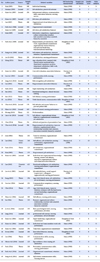Abstract
Purpose
In this study a systematic review and meta-analysis was used to examine the variables related to self-leadership in Korean clinical nurses.
Methods
A search and screening of the literature uncovered, 49 related studies done between 2003 and 2016 were then reviewed. A meta-analysis of 44 studies from doctoral dissertations, master's thesis and published articles was also carried out. The correlational effect size (ESr) for each related variable was calculated.
Results
Sixty-nine related variables were identified from the systematic review. Twenty-three (5 personal, 13 professional and 5 organizational) variables were eligible for meta-analysis. The overall effect size was .47. The personal factors (ESr=.48) and the professional factors (ESr=.44) had larger effect size than the organizational factors (ESr=.28). Factors with the largest effect size among personal, professional and organizational factors were self-efficacy (ESr=.58), nursing service (ESr=.68) and supervisor's leadership (ESr=.36) respectively.
Conclusion
The results of this study show that for Korean clinical nurses individual factors including personal or professional factors have a stronger impact on self-leadership than organizational factors. It is necessary to develop interventions and training programs which focus on improving self-efficacy to promote self-leadership in clinical nurses.
Figures and Tables
References
1. Manz CC. Self-leadership: Toward an expanded theory of self-influence processes in organizations. Academy of Management Review. 1986; 11(3):585–600. DOI: 10.5465/AMR.1986.4306232.

2. Houghton JD, Neck CP. The revised self-leadership questionnaire: Testing a hierarchical factor structure for self-leadership. Journal of Managerial Psychology. 2002; 17(8):672–691. DOI: 10.1108/02683940210450484.

3. Seomun GA, Chang SO, Cho KH, Kim IA, Lee SJ. The relation between self-leadership and outcome of nursing practice. Journal of Korean Academy of Nursing Administration. 2006; 12(1):151–158.

4. Won HJ, Cho SH. A review of research on self-leadership in nurses. Journal of Korean Academy of Nursing Administration. 2013; 19(3):382–393. DOI: 10.11111/jkana.2013.19.3.382.
5. Kim SY, Kim EK, Kim B, Lee E. Influence of nurses' self-leadership on individual and team members' work role performance. Journal of Korean Academy of Nursing. 2016; 46(3):338–348. DOI: 10.4040/jkan.2016.46.3.338.
6. Alves JC, Lovelace KJ, Manz CC, Matsypura D, Toyasaki F, Ke K. A cross-cultural perspective of self-leadership. Journal of Managerial Psychology. 2006; 21(4):338–359. DOI: 10.1108/02683940610663123.

7. Song HJ, Lee SM. The effects of hospital nurses' self-esteem and communication skill on self-leadership and the quality of nursing service. Journal of Korean Academy of Nursing Administration. 2016; 22(3):220–229. DOI: 10.11111/jkana.2016.22.3.220.

8. DiLiello TC, Houghton JD. Maximizing organizational leadership capacity for the future: Toward a model of self-leadership, innovation and creativity. Journal of Managerial Psychology. 2006; 21(4):319–337. DOI: 10.1108/02683940610663114.
9. Lee HS. The structural equation model analysis of related variables on nursing performance of clinical nurses [dissertation]. Busan: Kosin University;2014.
10. Kim IS, Won SA, Kang SJ, Shin SM. The relationship among nurses' perception of super-leadership, self-leadership and organizational commitment. Journal of Korean Academy of nursing Administration. 2016; 22(2):148–157. DOI: 10.11111/jkana.2016.22.2.148.

11. Choi S, Jang I, Park S, Lee H. Effects of organizational culture, self-leadership and empowerment on job satisfaction and turnover intention in general hospital nurses. Journal of Korean Academy of Nursing Administration. 2014; 20(2):206–214. DOI: 10.11111/jkana.2014.20.2.206.

12. Kim YH, Lee YM. Influence of self-leadership on job stress, job satisfaction and burnout among nurses in hospitals. Journal of the Korean Data Analysis Society. 2009; 11(4):1939–1951.

13. Borenstein M, Hedges LV, Higgins JPT, Rothstein HR. Introduction to meta-analysis. West Sussex, UK: Wiley;2009.

14. Shin IS. Recent research trends in meta-analysis. Asian Nursing Research. 2017; 11(2):79–83. DOI: 10.1016/j.anr.2017.05.004.
15. Estabrooks CA, Floyd JA, Scott-Findlay S, O'Leary KA, Gushta M. Individual determinants of research utilization: A systematic review. Journal of Advanced Nursing. 2003; 43(5):506–520. DOI: 10.1046/j.1365-2648.2003.02748.x.
16. Cicolini G, Comparcini D, Simonetti V. Workplace empowerment and nurses' job satisfaction: A systematic literature review. Journal of Nursing Management. 2014; 22(7):855–871. DOI: 10.1111/jonm.12028.
17. Cohen J. Statistical power analysis for the behavioral sciences. 2nd ed. Hillsdale, NJ: Erlbaum;1988.
18. Higgins JPT, Thompson SG. Quantifying heterogeneity in a meta-analysis. Statistics in Medicine. 2002; 21(11):1539–1558. DOI: 10.1002/sim.1186.
19. Manz CC. The art of self-leadership: Strategies for personal effectiveness in your life and work. Englewood Cliffs, NJ: Prentice-Hall;1983.
20. Prussia GE, Anderson JS, Manz CC. Self-leadership and performance outcomes: The mediating influence of self-efficacy. Journal of Organizational Behavior. 1998; 19(5):523–538. DOI: 10.2307/3100241.

21. Sutton AJ, Duval S, Tweedie R, Abrams KR, Jones DR. Empirical assessment of effect of publication bias on meta-analyses. BMJ. 2000; 320(7249):1574–1577. DOI: 10.1136/bmj.320.7249.1574.

22. Kim KH, Kim JH. Self-leadership in Korea: Review and theoretical implication. Korean Leadership Quarterly. 2014; 6(1):77–98.

23. Sim SM. Study on nurses' self-leadership, self-efficacy and outcomes of nursing practices [master's thesis]. Gangneung: Gangneung-Wonju National University;2012.

24. Kim HK. Influence of interpersonal relations, communication skills, creative behaviors and nursing services on self-leadership among nurses in hospitals. Journal of Korean Clinical Nursing Research. 2007; 13(1):25–36.
25. Yu S, Ko Y. Communication competency as a mediator in the self-leadership to job performance relationship. Collegian. 2017; 24(5):421–425. DOI: 10.1016/j.colegn.2016.09.002.
26. Kwon JO. Nursing performance and innovative behavior as factors affecting the self-leadership of geriatric hospital nurses. Korean Journal of Health Service Management. 2016; 10(1):53–66. DOI: 10.12811/kshsm.2016.10.1.053.

27. Han SJ. A study on the relationship between nursing organizational culture and organizational performance. Journal of Korean Academy of Nursing Administration. 2002; 8(3):441–456.

28. Neck CP, Manz CC. Thought self-leadership: The impact of mental strategies training on employee cognition, behavior, and affect. Journal of Organizational Behavior. 1996; 17(5):445–467.
29. Shin YK, Kim MS, Han YS. A study on the validation of the Korean version of the revised self-leadership questionnaire (RSLQ) for Korean college students. Korean Journal of School Psychology. 2009; 6(3):313–340. DOI: 10.16983/kjsp.2009.6.3.377.




 PDF
PDF ePub
ePub Citation
Citation Print
Print








 XML Download
XML Download